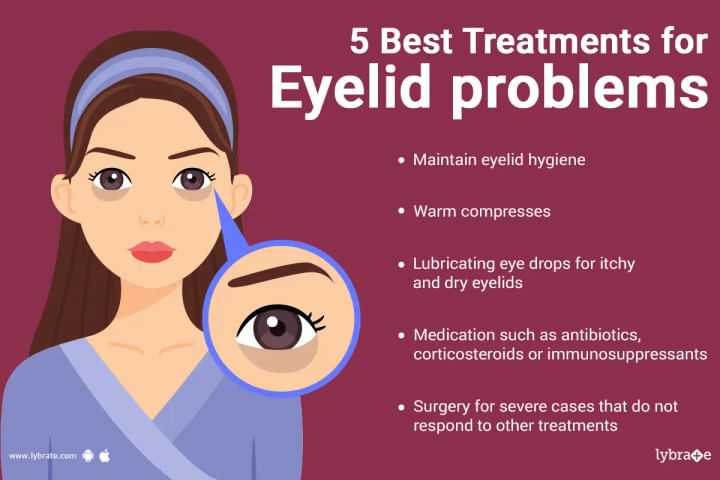Eyelid Problems - Sings, Complications, Causes and Treatment
What are Eyelid Problems?
Eyelid problems are a group of disorders that affect any part of the eyelid, such as the lid itself, the tear ducts, the lashes or the eyebrows. These problems can range from minor irritations to serious medical conditions.
Blepharitis: It is one of the most common eyelid problems. It occurs when bacteria on the eyelid causes inflammation and irritation.
Other common eyelid problems include ptosis (droopy lids), entropion (inversion of the lid margin), chalazions (clogged oil glands) and tumours. Eyelid issues can often be treated with medications, surgery or even natural remedies depending on their severity.
What are the signs and symptoms of Eyelid Problems?
The most common signs and symptoms of eyelid problems include:
- Swelling and redness of the eyelid
- Itching or burning sensation in the eyes
- Sensitivity to light
- Discharge from the eyes
- Loss of vision or double vision in one or both eyes
- Inability to fully close the eyelids due to an obstruction (ptosis)
- Abnormal bumps, cysts, or lesions on the eyelids.
What are possible complications of Eyelid Problems?
The complications of eyelid problems can vary depending on the underlying cause and can range from minor to serious.
Common complications include:
- Ulcerations, scarring, or infection of the eyelid
- Blepharospasm, an involuntary twitching of the eyelids that can lead to blurred vision and dry eyes
- Ectropion, a condition where the lower lid droops away from the eyeball
- Entropion, a condition where the lower lid rolls inward toward the eyeball
- Trichiasis, an irritation caused by ingrown lashes rubbing against the eye surface
- Loss or distortion of eyelashes
- Ptosis (drooping) of one or both upper lids which can block vision or impair field of vision.
In rare cases more severe complications may occur including impaired vision due to corneal erosion, corneal ulceration or infection leading to vision loss in extreme cases. In such cases it is important to seek medical attention as soon as possible.
Eyelid Problems: Causes and Treatments
Eyelid problems can range from annoyances, such as dryness and itchiness, to more serious issues, such as eyelid inflammation or tumours. These problems may affect the way your eyes look and the way they work. The following are some of the most common causes and treatments of eyelid issues.
Infections: Bacterial infections and viral conjunctivitis (pinkeye) are common causes of eyelid irritation, pain, redness or swelling. Infections can also cause watery eyes.
- Treatments include antibiotics or antiviral medications applied directly to the eye. In some cases, corticosteroid eye drops may be needed to reduce inflammation associated with the infection.
- Allergies: Allergy flare-ups often affect the eyes in addition to other parts of the body. Allergic reactions can cause itching and irritations in both the eyes and eyelids that vary from mild to severe depending upon individual susceptibility.
- Treatment includes using special eye drops or oral medications to relieve symptoms such as itchy eyes and watery discharge due to allergies.
- Eyelid inflammation due to allergies requires additional treatment using Corticosteroids (steroidal medicines).
- Allergy shots may be needed for a long-term relief from specific allergens causing flare-ups on your eyelids or nearby areas near vision organs like nose or throat area cavity etc..
Blepharitis: Blepharitis is an inflammation of the eyelids that usually results from an underlying skin condition such as seborrheic dermatitis or acne rosacea.
Common symptoms include itching, burning sensation, redness around eyelids & crusting of lashes area when you wake up in morning this indicates that you have blepharitis which requires topical antibiotics treatment plus good hygiene like daily wiping near lashes region with warm nutrient salt water solution etc…
Treatment options include regular cleaning with warm saltwater soaks & lid scrubs/gels along with varying doses of anti-inflammatory medications like antibiotic ointments/oral medicines prescribed by doctor if necessary which reduces further risk factors leading towards infective conjunctivitis complications & potential retention cyst OR hordeolum formation on lids itself which further aggravates condition worsening situation & spiral even worsening it more dramatically endangering vision health!
What are the surgical treatments for Eyelid Problems?
Surgical treatments for eyelid problems depend on the particular condition being treated.
Common techniques include lid lifts, wherein the eyelids are repositioned to improve the appearance of drooping upper lids; ptosis repair, for treatments which involve repairing weak muscles and tendons of the upper lid; and blepharoplasty (eyelid surgery), for conditions such as lax skin or puffiness.
- Lid lifts: Eyelid lifts can be performed to correct droopy or sagging eyelids. This is a surgical procedure where extra skin and fat are removed from the eyelid area to correct functional problems such as double vision, obstructed vision, or difficulty wearing glasses. This procedure can also improve your overall appearance by opening up your eyes more and providing you with younger-looking eyes.
- Blepharoplasty: Blepharoplasty is a surgical procedure that is used to treat a variety of conditions and abnormalities related to the eyelids, such as drooping upper eyelids, sagging or wrinkled skin around the eyes, and excessive skin on the upper or lower eyelids. During this procedure, excess skin and fat may be removed from the eyelid area in order to achieve a more youthful and refreshed appearance. In some cases, it can also be used to improve vision if the extra skin of the upper lid droops down enough to impact peripheral vision.
- Other surgical methods: Such as skin flaps, may also be employed depending on the eyelid issue in question. In general, surgical options are normally chosen when non-surgical options have failed or when an anatomical deformity requires more drastic measures than medications or lifestyle changes can provide.
Best doctors to consult for Eyelid Problems?
- Ophthalmologist: Ophthalmologists specialise in eye and vision health, and are experts at diagnosing and treating diseases related to the eyelids. If you have an eyelid problem, they are the best doctors to see.
- Dermatologist: Dermatologists have extensive knowledge of skin conditions, including those that may affect the eyelids. They can perform procedures like chemical peels and laser treatments to treat certain eyelid problems such as cysts or benign tumours that can form on the lid or around the eyes.
- Optometrist: Optometrists are health care professionals who specialise in examining, diagnosing, and managing vision disorders with glasses or contact lenses. They can detect minor problems in the eyes or eyelids that may require treatment by an ophthalmologist to avoid further complications down the line.



+1.svg)
